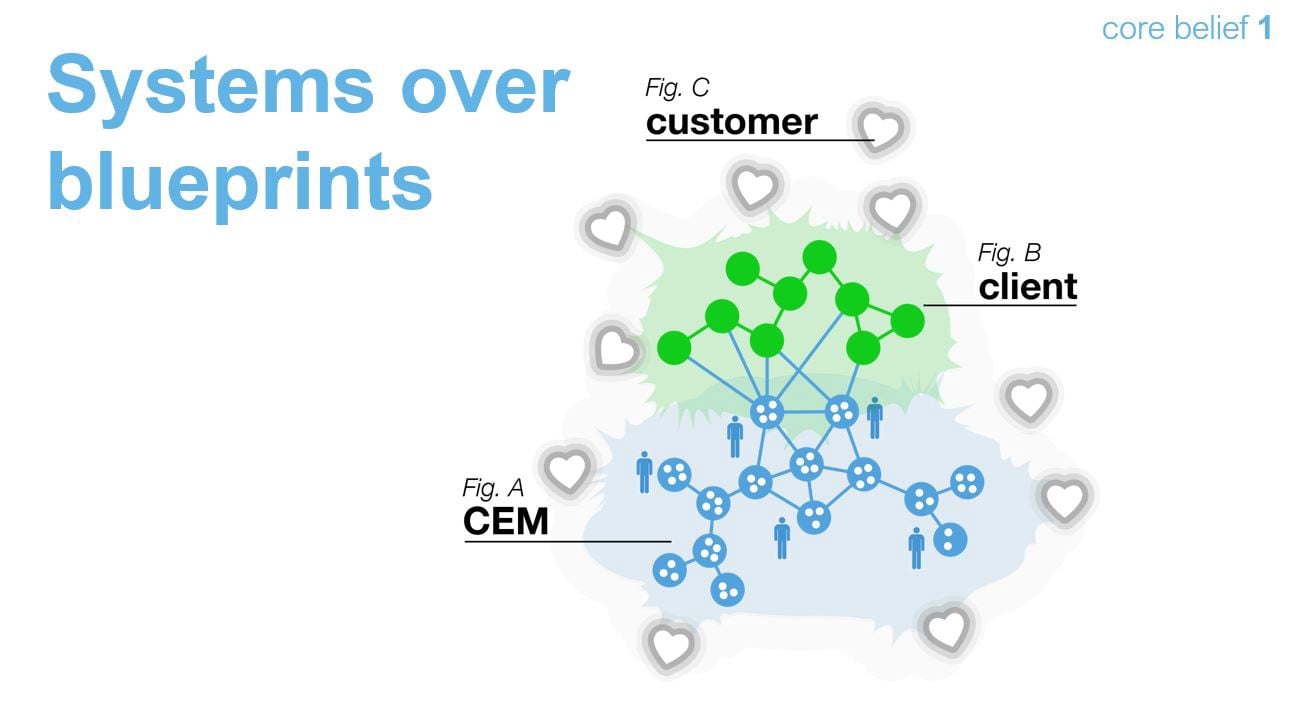
Organization as living organism and complex adaptive system
Organization as a living organism, often discussed as complex adaptive system in academic world, is an interesting and also a bit hard to grasp perspective.
There is analogue to many phenomena in the nature; e.g. how the flock of birds or school of fish adapt and react to all the changes in their environment as one highly synchronized constellation.
Our blog series (Opening blog) started by describing the big difference of “Organizations as machines” vs. “Organizations as living organisms”. This difference is essential when aiming to unleash the power of purpose for organizations (Blog No 9) and individuals (Blog No 10).
Systems theory and systems thinking are at the heart of this approach. In organizational context that would mean that we look at organization as a system, as a whole, understanding that the value is built into the relations between different parts of the organization and to optimize it we need to have a holistic view rather than optimizing just small pieces at time.

School of fish forming a adaptive network and living organism
Systems Theory history overview
General Systems Theory was already founded in 1960s and has since then been researched and used in different branches of science (biology, finance, human interaction etc.). In organizational context studies often use the metaphor of “living biological organism”. These studies and the pioneering work of Daniel Katz and Robert Kahn year 1966 offered an alternative perspective to classical management. That time, management models and taylorism considered organizations as machines. Systems Theory instead started to consider organizations as living organisms and later, complex adaptive system theory was born.
Organizations as Complex Adaptive System in a nutshell
In Complex Adaptive System theory, organization is considered as a constantly changing living organism where different parts (of very different size and type) are interrelated and change is emergent. The reason for such approach for organizations comes from the change of the environment we live in. We can all see how world is moving towards VUCA (Volatile, Uncertain, Complex, Ambiguous) which requires highest adaptation capabilities that the traditional organizations don’t provide. System should always be viewed as a whole, not as a collection of pieces. Changes to one part has always influence on the other parts. The idea is that the system is much greater than the sum of its parts.
System is constantly changing. This happens in a self-organized manner where local micro level interaction of the parts makes the system to automatically adapt to changing situation and environment.
Short feedback loops are important in systems adaptation and evolution. Negative feedback will re-establish the steady course back, whereas positive feedback will amplify the things that provided it.
Systems thinking and systemic value creation in our own context
Systems thinking is the key element of one of our four core beliefs. Our Core Belief #1 is called “Systems over Blueprints”. Core beliefs, for us, are four strong statements that define what we deeply believe in. All the decisions we make are based on our Core Beliefs. They are helping anyone in the organization to choose the right way.

Our Core Belief #1: systems thinking and systemic value creation
Systems over blueprints for us means that we don’t believe in organizing our operations with pre-defined processes, operational blueprints and fixed role descriptions. Instead we consider our organization as a system, where teams and individuals are constantly learning and adapting their operations based on the changing environment and situation. There is no “one best way to do things”. Instead, the teams are all the time trying to learn and iteratively find the fit-for-purpose way to do things. Co-operation in the network with extreme transparency and sharing of learnings is essential for the system to develop and scale on macro level.
The idea of systemic value creation is at the heart of our operations. It means that all the parts of the system, individuals and teams, are constantly seeking for the optimal ways for creating value for the system and hence, value for the purpose the system is built for. Instead of giving commands, the leaders in the system are trying to see the whole system and enable maximal value creation for the different parts.
As we can see in the picture, we consider our clients to be part of the same system, where we together with the clients aim at creating maximal value to the end customers, the customers of our clients.
Referring back to the ideas in the previous blog (Blog No 10) the leaders shall not only focus on enabling the maximal value creations for the parts. In addition to that they need to be sensing the mode of teams and individuals and aim to find the sweet-spot where both the team’s and individual’s inspiration meets the systemic value creation. When finding that sweet-spot, great things start to happen and system really start to live.
Moving System Thinking from slides to reality
In our 600+ people organization we have iteratively developed a set of boarding modules that we use for helping the teams to develop their operations towards our future target state of living organism.
One of our boarding modules is focusing on systemic value creation. While the previous modules are focusing on team’s own identity, mission, vision and understanding of the business they generate, this module is all about how the team is part of the whole system, how they generate value for the system and how do they get value from the system. When driving for teams with high autonomy we always have a risk of building smaller silos (teams) that would only care about their own things if we were not widening the team’s perspective to system level thinking and mindset.
In the boarding module with our teams we discuss about the key drivers of behavior in a traditional machine alike organizations vs. living organism. Often, in traditional organizations the key behavioral driver is to delight one’s manager which has multiple negative and limiting consequences. In living organism, it should be about where can one create highest value for the system and where that meets person’s own inspiration the best. In the boarding sessions we also look at the system we have and start identifying how the team is related to the system and where are the most important interrelations to other teams and value streams between them. This exercise might sometimes feel too obvious or too simple first, but the key is to change the viewpoint and mindset. It is fantastic to see how teams start to see their value based on who they work with and what the whole system tries to achieve rather than just their own part. It makes their part much more meaningful and builds the purpose stronger as well.
Systemic value creation in recruitment discussions
Systems over blueprints Core Belief and the idea of systemic value creation has an important role in all our new recruitment discussions. We explain this idea in detail to our potential new colleagues and instead of discussing about fixed roles and job description, we are having a dialogue with the candidate for together identifying the possibilities where the candidate’s inspiration and value to our system would match. As the system is continuously changing also the value creation and roles of the people are changing. In the discussions with new candidates we try to find an area where the person has a good chance to start the work but there is even more focus on looking the future and potential areas for value creation in longer term. All this leads to our value proposition being that everyone should have maximal freedom to seek for the place and role in the organization where the one’s value and inspiration are at highest leading to maximal engagement and hence, maximal value created.
How does it feel in real life for managers / leaders
Leading an organization as a machine or as a living organism are two totally different things. We have experienced both worlds. Enabling value creation for others vs. giving commands to others make your interaction with people totally different. The change doesn’t happen overnight, for us it has required long process of reflections, thinking, testing, failing and great moments of success that bring you confidence. One specific requirement to the leaders is that they shall not focus on their territory, instead they shall be good at understanding how the whole systems works with a good eye on sensing the mode of different parts in the system.
We have also organized all our sales operations with the same ideas. Letting the traditional ideas of Predict & Control and Carrot & Stick go and starting to organize sales as a living organism with Mastery-Autonomy-Purpose. That has really been an exciting journey.
With passion and humility,
Jaakko Hartikainen & Mikko Virtanen
Our blog series:
No 1: Call for Paradigm Shift in Management
No 2: Magnitude of Change when Shifting Management Paradigm
No 3: Why do so many companies manage people like machines and why is it one of the biggest problems of our times?
No 4: How to drive paradigm level change? Our learnings and one crucial breakthrough innovation
No 5: Incredible India and breaking the hierarchy
No 6: Management paradigms in a nutshell, inspired by Frederic Laloux's book Reinventing Organizations
No 7: Our unforgettable journey to trust, transparency and eventually success
No 8: We all know that “Carrot and Stick” model is outdated — Why is it so damn hard to implement new ways?
No 9: The Power of Purpose
No 10: Finding your purpose and living your life with it can unleash tremendous potential
No 11: Organization as living organism and complex adaptive system

Fredrik is a leading expert on data-driven business-transformation, with a passion for finding new business opportunities from ecosystem-based co-innovation and co-creation. He is participating in significant national and international programs and ecosystems innovating and bringing the data economy to the next level.



